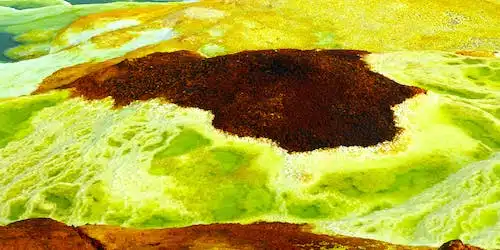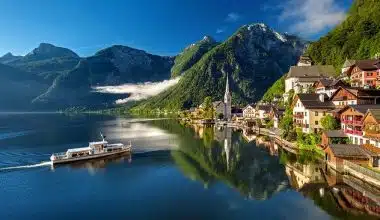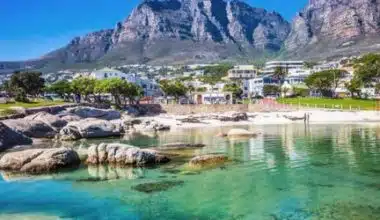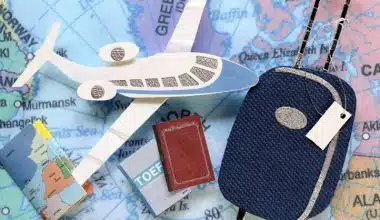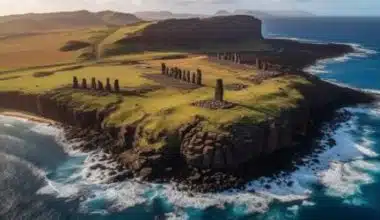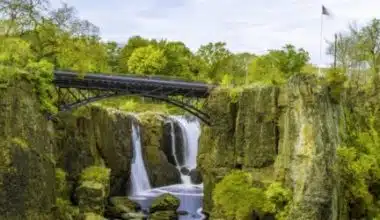Descend into the otherworldly landscapes of the Danakil Depression, a geological wonder and one of the hottest places on Earth. The Danakil Depression, located in northern Ethiopia, is known for its unique landscapes, including salt lakes, volcanoes, and geothermal activity. It is often referred to as a “gateway to hell” and a “land of death” due to its harsh conditions and extreme temperatures. The depression is also recognized as a geological heritage site, offering opportunities for mineralogical research and understanding Earth’s geological history.
Danakil Depression
The Danakil Depression is a geological depression located in the Afar region of northern Ethiopia. It extends into Djibouti and Eritrea as well. This region is known for its unique and extreme landscapes, including salt lakes, volcanoes, and geothermal activity. The Danakil Depression is often described as one of the most alien and inhospitable places on Earth. It has been referred to as a “gateway to hell” and a “land of death” due to its harsh conditions and extreme temperatures. It is considered one of the hottest places on Earth.
Features of the Danakil Depression
The Danakil Depression is known for its unique and extreme geological features, which include
#1. Continental Rifting
The Danakil Depression lies at the junction of three tectonic plates: the Arabian, Somali, and Nubian plates. These plates are moving apart, causing the Earth’s crust to thin and creating a rift. This process, known as continental rifting, has shaped the landscape of the Danakil Depression.
#2. Volcanic Activity
The Danakil Depression has a history of volcanic activity. Extensive lava flows have resulted in the formation of basalt, which overlies sedimentary rocks such as sandstone and limestone. This volcanic activity has contributed to the unique geological formations in the region.
#3. Salt Lakes
The Danakil Depression is home to salt lakes, which are a result of the region’s high evaporation rates. The lakes contain high concentrations of salt and minerals, creating vibrant and colorful landscapes.
#4. Hot Springs
The Danakil Depression features hot springs, including bright yellow ones. These hot springs are a manifestation of the geothermal activity in the region. The Earth’s crust is thinning, allowing heat from the mantle to reach the surface and create these geothermal features.
#5. Acid Springs
The Danakil Depression is also known for its acid springs. One notable example is the Dallol crater, which features a deep crater filled with acidic water. These acid springs are a result of the interaction between volcanic gasses and groundwater.
#6. Bubbling Mud Pools
The Danakil Depression is home to bubbling mud pools, which are formed by the interaction of geothermal heat and underground water. These mud pools create a surreal and otherworldly landscape.
#7. Geological Heritage
The Danakil Depression is recognized as a geological heritage site due to its unique geological features and processes. It provides opportunities for mineralogical research and contributes to our understanding of the Earth’s geological history.
#8. Lava Lakes
The Danakil Depression is home to lava lakes, which are pools of molten lava that can be observed within volcanic craters. These lava lakes create a mesmerizing and dramatic sight, with their glowing red and orange hues.
#9. Colorful Mineral Deposits
The region is known for its colorful mineral deposits, which are a result of volcanic activity and geothermal processes. These deposits create vibrant hues of yellow, green, orange, and other striking colors that add to the surreal beauty of the landscape.
#10. Salt Pans
The Danakil Depression features vast salt pans, also known as salt flats or salt deserts. These expansive areas are covered with a thick layer of salt, creating a dazzling white landscape. The salt pans are a result of the region’s high evaporation rates and the presence of saltwater lakes.
Things To Do In The Danakil Depression
#1. Visit the Salt Lakes
Explore the mesmerizing salt lakes of the Danakil Depression. These lakes, such as Lake Assale, are known for their high salt concentrations and vibrant colors.
#2. Witness the Volcanic Activity
Experience the unique opportunity to witness volcanic activity up close. The Danakil Depression is home to volcanoes, including Erta Ale, which has a lava lake that can be observed.
#3. Explore the Colorful Mineral Deposits
Marvel at the colorful mineral deposits found in the Danakil Depression. These deposits create stunning hues of yellow, green, orange, and other vibrant colors, adding to the surreal beauty of the landscape.
#4. Visit the Acid Springs
Discover the acid springs in the region, such as those found in the Dallol area. These acidic pools and springs are a result of the interaction between volcanic gases and groundwater.
#5. Experience the Bubbling Mud Pools
Witness the bubbling mud pools that dot the Danakil Depression. These mud pools are formed by the interaction of geothermal heat and underground water, creating a unique and otherworldly sight.
#6. Trek to Erta Ale
Embark on a trek to the Erta Ale volcano, which is known for its active lava lake. This challenging but rewarding trek offers the opportunity to witness the raw power of nature.
#7. Interact with the Local Afar People
Engage with the local Afar people who call the Danakil Depression home. Learn about their way of life, culture, and traditions.
#8. Take in the Alien-Like Landscapes
Immerse yourself in the surreal and alien-like landscapes of the Danakil Depression. From the salt flats to the volcanic craters, the region offers a truly unique and otherworldly experience.
#9. Photography Opportunities
Capture the breathtaking beauty of the Danakil Depression through photography. The striking colors, dramatic landscapes, and unique geological formations provide ample opportunities for stunning shots.
#10. Experience Life in Extreme Environments
Gain a deeper understanding of life’s resilience in extreme environments. The Danakil Depression is home to unique microbial life forms that have adapted to survive in the harsh conditions.
Danakil Depression Tour
A tour of the Danakil Depression offers a unique and unforgettable experience. Several tour operators offer tours to the Danakil Depression, including Experience Ethiopia Travel (ETT), World Sun Ethiopia Tours, Pangeans Safari, and Boundless Ethiopia.
Characteristics of the Danakil Depression Tour
#1. Duration
Tours to the Danakil Depression typically range from 2 to 4 days, depending on the itinerary and the specific attractions included. Some tours may also include visits to other nearby sites of interest.
#2. Highlights
The tour will take you to the main attractions of the Danakil Depression, such as salt lakes, volcanic craters, lava lakes, acid springs, and bubbling mud pools. You will have the opportunity to witness the extreme landscapes and geological wonders of the region.
#3. Guides and Safety
It is highly recommended to join a tour with experienced guides who are familiar with the area and its challenges. The Danakil Depression can be a harsh and inhospitable environment, so having knowledgeable guides ensures your safety and enhances your understanding of the region.
#4. Logistics and Transportation
Tours include transportation to and from the Danakil Depression, as well as within the region itself. This may involve 4×4 vehicles or other suitable means of transportation to navigate the rugged terrain.
#5. Accommodation
Accommodation during the tour is usually in basic camps or lodges that provide the necessary facilities for a comfortable stay in the remote desert environment. It’s important to note that the accommodation may be basic, with limited amenities.
#6. Cost
The cost of a Danakil Depression tour can vary depending on the duration, inclusions, and level of comfort. Prices can range from around $250 to $600, with additional costs for optional activities or upgrades.
#7. Physical Fitness and Preparation
The Danakil Depression tour involves some physical exertion, including walking on uneven terrain and potentially enduring high temperatures. It is important to be in good physical condition and adequately prepared with appropriate clothing, footwear, and supplies.
#8. Permits and Regulations
Some areas within the Danakil Depression may require permits for entry. It is essential to check the latest regulations and ensure that all necessary permits are obtained before embarking on the tour.
#9. Photography Opportunities
The Danakil Depression offers incredible photography opportunities with its unique landscapes and geological formations. Make sure to bring your camera and capture the stunning beauty of the region.
#10. Local Culture and Interaction
During the tour, you may have the chance to interact with the local Afar people, learning about their culture, traditions, and way of life. Respect for local customs and traditions is important when engaging with the local community.
Tips For Going On A Danakil Depression Tour
#1. Choose a Reputable Tour Operator
Research and select a reputable tour operator that specializes in Danakil Depression tours. Read reviews and consider recommendations from other travelers to ensure a reliable and well-organized experience.
#2. Be Prepared for Long Driving Hours
Expect long hours of driving during the tour, especially on the first day. The distances are long, and the road conditions can be poor. Be mentally prepared for extended periods in a Landcruiser with limited legroom and potentially uncomfortable conditions.
#3. Pack Essential Items
Prepare a packing list that includes essential items for the tour. This may include appropriate clothing for extreme temperatures, comfortable walking shoes, sunscreen, a hat, sunglasses, a reusable water bottle, and any necessary medications or personal care items.
#4. Be Mindful of Garbage
Unfortunately, there is some garbage in the Danakil Depression, particularly around popular sites like the Erta Ale volcano. Pack your garbage and bring it back to town with you to help keep the area clean and preserve its natural beauty.
#5. Follow Safety Guidelines
Listen to your tour guide and follow their instructions for safety. The Danakil Depression can be a challenging environment, so it’s important to adhere to safety guidelines and use common sense during the tour.
#6. Expect Basic Accommodations
Be prepared for basic accommodations during the tour. Camps or lodges in the Danakil Depression may have limited amenities, so adjust your expectations accordingly.
#7. Stay Hydrated
The Danakil Depression is known for its extreme heat, so it’s crucial to stay hydrated throughout the tour. Drink plenty of water and follow your guide’s recommendations for staying hydrated in the desert environment.
#8. Respect Local Customs and Environment
Show respect for the local Afar people and their customs. Be mindful of the fragile environment and avoid damaging or disturbing the natural surroundings.
#9. Acclimate to the Environment
The Danakil Depression is located at a low altitude and experiences extremely high temperatures. If possible, arrive a few days early in Ethiopia to acclimate to the climate and minimize the risk of heat-related issues during the tour.
#10. Bring Cash in Small Denominations
Cash is essential in remote areas where credit card facilities may not be available. Carry enough Ethiopian Birr in small denominations to cover expenses like tips, local purchases, and any unforeseen circumstances.
Is It Safe To Visit Danakil Depression?
The safety of visiting the Danakil Depression can vary. While it is generally considered safe for tourists, it is important to choose a reputable tour operator and follow their safety guidance. It recommended staying updated on the current situation and following travel advisories. The region has its unique challenges, such as extreme heat and inhospitable conditions, so being prepared and following safety guidelines is crucial.
Does Anything Live In The Danakil Depression?
The Danakil Depression is home to resilient forms of life, including microbes and bacteria in the hot springs and hydrothermal environments. The Afar people also live in the region, adapting to the challenging conditions. While the Danakil Depression is known for its geological features, such as sulfur springs and an active volcano, its biodiversity is not as prominent. The presence of life in this extreme environment provides insights into the limits of life and its potential existence in similar harsh environments elsewhere.
Can You Swim In The Danakil Depression?
Swimming in the Danakil Depression is not a common activity due to the nature of the region. The high temperatures, extreme conditions, and the presence of salt crust on the surface of the lakes make swimming impractical or impossible in most areas. However, there are some reports and footage showing travelers swimming in natural pools in the Danakil Depression. Nevertheless, these instances may be limited to specific locations and should be done with caution and under the guidance of experienced tour operators.
Why Is The Danakil Depression Green?
The Danakil Depression is not typically described as green. The region is known for its surreal and alien landscapes, characterized by vibrant colors such as yellows, greens, and other hues. The presence of neon green and yellow colors can be observed in the luminescent ponds and sulfur springs found in the area. These colors are a result of various factors, including the presence of minerals, sulfuric crust, and the seepage of rain and seawater from nearby coasts.
What Language Does Danakil Speak?
The Afar people speak the Afar language, which is part of the Cushitic branch of the Afroasiatic language family. The Danakil people, also known as the Afar people, inhabit the Danakil Depression. They are a Cushitic-speaking ethnic group living in the Horn of Africa, primarily in the Afar Region of Ethiopia, northern Djibouti, and the southern coast of Eritrea.
How Do People Live In Danakil?
The people living in the Danakil Depression, primarily the Afar people, have adapted to the challenging conditions of the region. They lead a nomadic lifestyle and rely on traditional practices such as raising camels, goats, and cattle for subsistence living. The Afar people have been living in the region for centuries and have developed resilience to the extreme heat and arid climate. They have also become involved in the tourism industry, providing services and guiding visitors to the unique geological features of the area, such as the sulphur springs of Dallol and the active volcano Erta Ale. Despite the harsh environment, the Afar people have managed to sustain their way of life in the Danakil Depression for generations.
Where To Avoid In Ethiopia?
Certain areas in Ethiopia may be advised to avoid or exercise caution due to security concerns. These areas include border regions, the capital city of Addis Ababa, northern regions affected by armed conflict and civil unrest, and the Somali region. It is also recommended to exercise caution when traveling by road in Ethiopia.
Why Is Danakil Depression Colorful?
The Danakil Depression is colourful due to various factors, such as the surreal and vibrant colours in the region, which come from the presence of minerals, sulphur, potash, and other elements that saturate the hydrothermal fields like Dallol. These minerals and elements react with rainwater, seawater from nearby coasts, and heated magma, resulting in a dazzling display of colours such as yellow, orange, red, blue, and green. The heat evaporates the water, leaving behind colourful crust-like deposits that mix with the turquoise lakes in the depression.
Conclulsion
Explore the Danakil Depression’s salt lakes, witness volcanic activity, explore colourful mineral deposits, visit acid springs, experience bubbling mud pools, trek to Erta Ale volcano, interact with local Afar people, and immerse yourself in the unique, alien-like landscapes. Enjoy the vibrant colours, colourful mineral deposits, and unique geothermal and underground water interactions. Experienced guides ensure safety and understanding of the harsh environment. To embark on a Danakil Depression tour, choose a reputable operator, prepare for long driving hours, pack essential items, be mindful of garbage, follow safety guidelines, and expect basic accommodations. Be prepared for long driving hours, limited legroom, and poor road conditions.
- THE BEST COUNTRY TO VISIT IN 2024
- AFRICAN SAFARI TRIPS: Unforgettable Encounters in the Heart of Africa
- IS CANCUN SAFE TO TRAVEL? All You Need To Know
- POST-VACATION DEPRESSION: How To Cope With It
- ROAD TRIP USA: Your Ultimate Guide to Discovering America’s Hidden Gems
